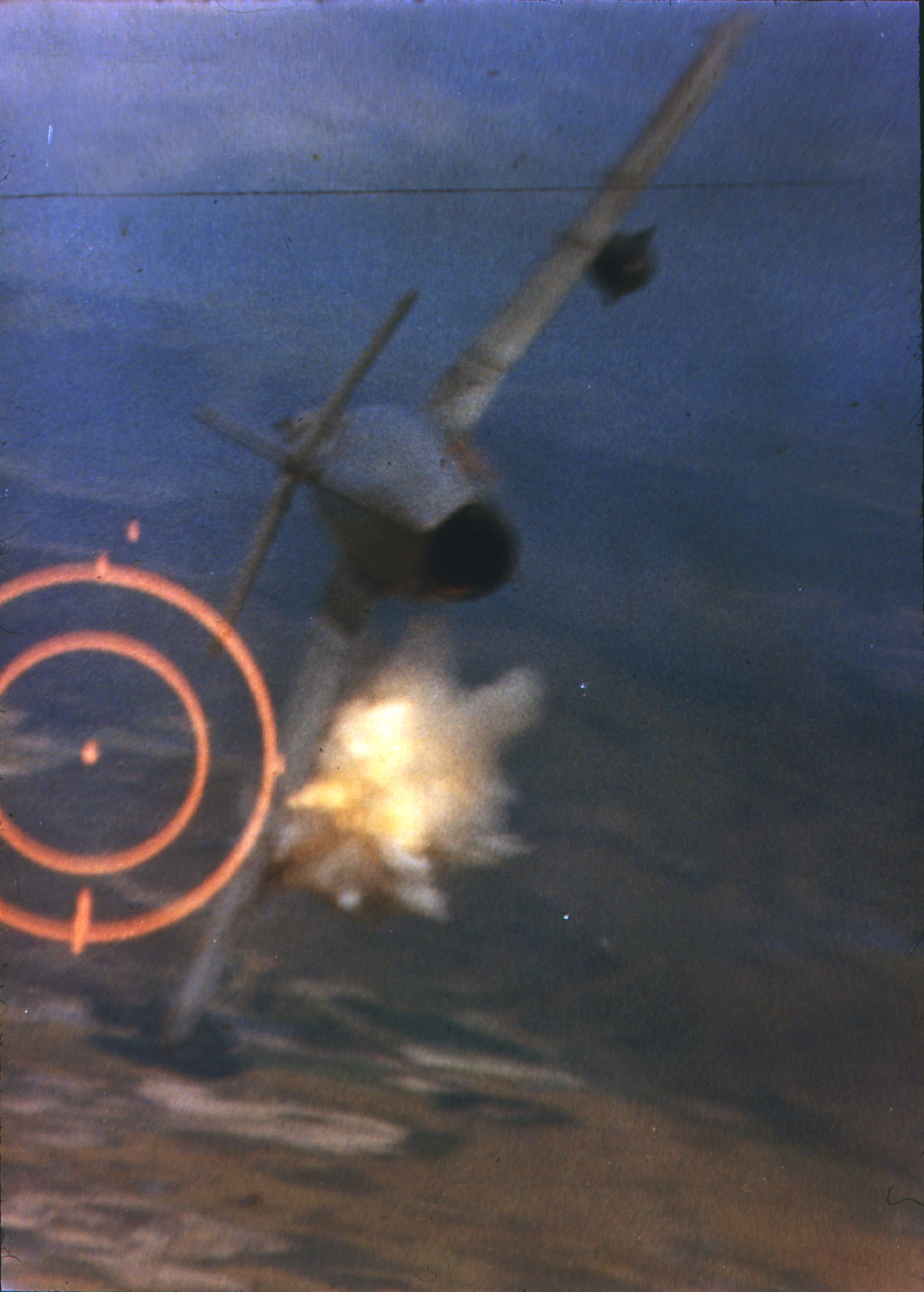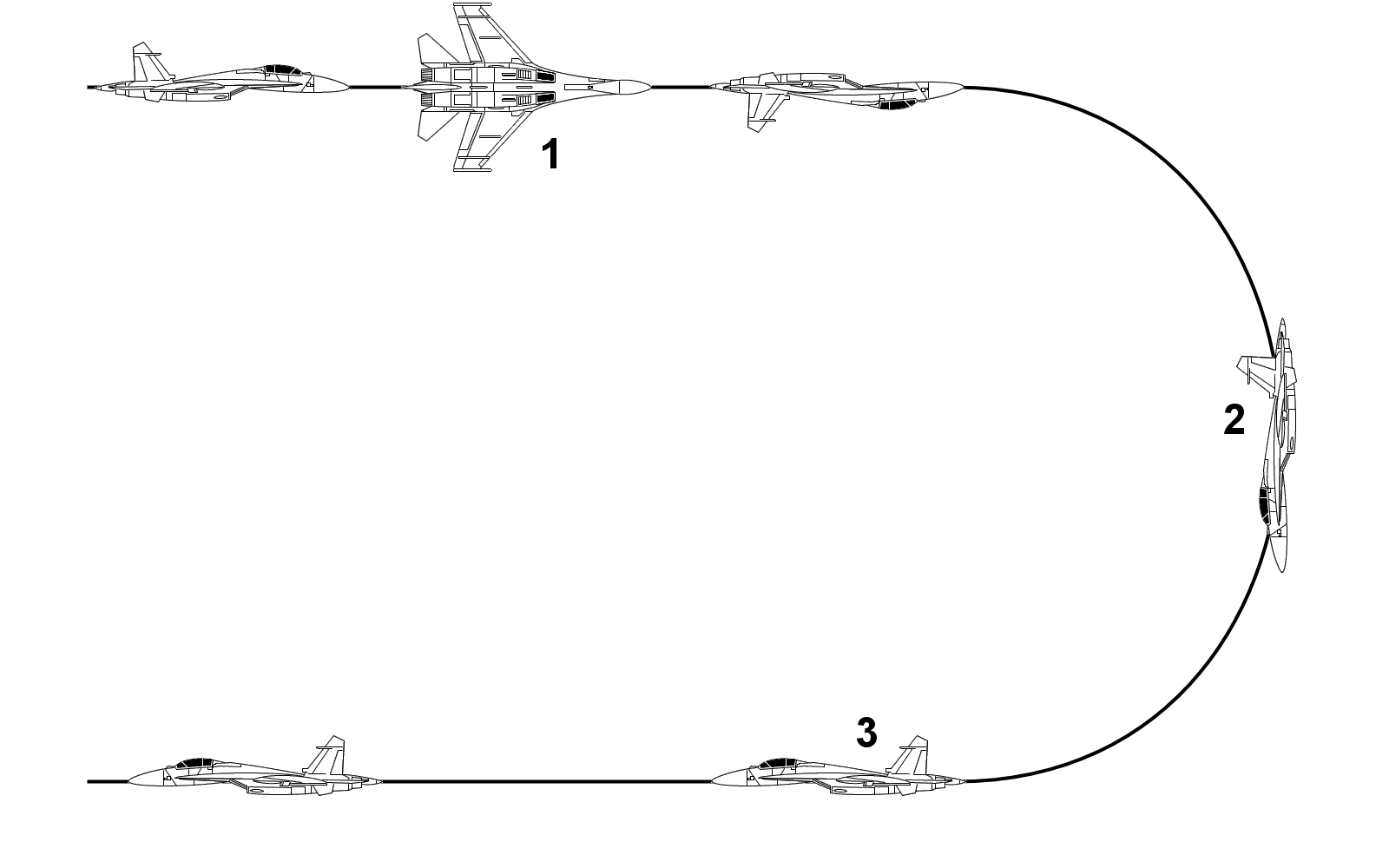|
Wingover
A wingover (also called a wing-over-wing, crop-duster turn or box-canyon turn) is an aerobatic maneuver in which an airplane makes a steep climb, followed by a vertical flat-turn (the plane turns to its side, without rolling, similar to the way a car turns). The maneuver ends with a short dive as the plane gently levels out, flying in the opposite direction from which the maneuver began. Sequence and use The aircraft makes a tight, 180 degree change in heading while covering minimum horizontal distance. The maneuver begins by making roughly a quarter loop, bringing the plane up into a vertical or near-vertical climb, allowing the airspeed to drop. Before the airplane stalls (begins to fall) the pilot applies hard rudder input, bringing the plane into a sweeping, vertical flat-turn, during which the wing swings over the top of the turn toward the direction of the nose. Both the lowered airspeed and gravity provide assistance with the turn, similar to a stall turn (hammerhead t ... [...More Info...] [...Related Items...] OR: [Wikipedia] [Google] [Baidu] |
Wingover Diagram With Birds Eye View
A wingover (also called a wing-over-wing, crop-duster turn or box-canyon turn) is an aerobatic maneuver in which an airplane makes a steep climb, followed by a vertical flat-turn (the plane turns to its side, without rolling, similar to the way a car turns). The maneuver ends with a short dive as the plane gently levels out, flying in the opposite direction from which the maneuver began. Sequence and use The aircraft makes a tight, 180 degree change in heading while covering minimum horizontal distance. The maneuver begins by making roughly a quarter loop, bringing the plane up into a vertical or near-vertical climb, allowing the airspeed to drop. Before the airplane stalls (begins to fall) the pilot applies hard rudder input, bringing the plane into a sweeping, vertical flat-turn, during which the wing swings over the top of the turn toward the direction of the nose. Both the lowered airspeed and gravity provide assistance with the turn, similar to a stall turn (hammerhead t ... [...More Info...] [...Related Items...] OR: [Wikipedia] [Google] [Baidu] |
Basic Fighter Maneuvers
Basic fighter maneuvers (BFM) are tactical movements performed by fighter aircraft during air combat maneuvering (ACM, also called dogfighting), to gain a positional advantage over the opponent. BFM combines the fundamentals of aerodynamic flight and the geometry of pursuit, with the physics of managing the aircraft's energy-to-mass ratio, called its specific energy. Maneuvers are used to gain a better angular position in relation to the opponent. They can be offensive, to help an attacker gain an advantage on an enemy; or defensive, to help the defender evade an attacker's weapons. They can also be neutral, where both opponents strive for an offensive position or disengagement maneuvers, to help an escape. Classic maneuvers include the lag pursuit or yo-yo, which add distance when the attacker may overshoot the target due to higher airspeed, the low yo-yo, which does the opposite when the attacker is flying too slow, the scissors, which attempts to drive the attacker in fro ... [...More Info...] [...Related Items...] OR: [Wikipedia] [Google] [Baidu] |
Aerobatic Maneuver
Aerobatic maneuvers are flight paths putting aircraft in unusual attitudes, in air shows, dogfights or competition aerobatics. Aerobatics can be performed by a single aircraft or in formation with several others. Nearly all aircraft are capable of performing aerobatics maneuvers of some kind, although it may not be legal or safe to do so in certain aircraft. Aerobatics consist of five basic maneuvers: * Lines (both horizontal and vertical), * loops, * rolls, * spins, and * hammerheads. Most aerobatic figures are composites of these basic maneuvers with rolls superimposed. A loop is when the pilot pulls the plane up into the vertical, continues around until they are heading back in the same direction, like making a 360 degree turn, except it is in the vertical plane instead of the horizontal. The pilot will be inverted (upside down) at the top of the loop. A loop can also be performed by rolling inverted and making the same maneuver but diving towards the ground. It can be v ... [...More Info...] [...Related Items...] OR: [Wikipedia] [Google] [Baidu] |
Aerobatic Loop
Aerobatics is the practice of flying maneuvers involving aircraft attitudes that are not used in conventional passenger-carrying flights. The term is a portmanteau of "aerial" and "acrobatics". Aerobatics are performed in aeroplanes and gliders for training, recreation, entertainment, and sport. Additionally, some helicopters, such as the MBB Bo 105, are capable of limited aerobatic manoeuvres. An example of a fully aerobatic helicopter, capable of performing loops and rolls, is the Westland Lynx. Most aerobatic manoeuvres involve rotation of the aircraft about its longitudinal (roll) axis or lateral (pitch) axis. Other maneuvers, such as a spin, displace the aircraft about its vertical (yaw) axis. Manoeuvres are often combined to form a complete aerobatic sequence for entertainment or competition. Aerobatic flying requires a broader set of piloting skills and exposes the aircraft to greater structural stress than for normal flight. In some countries, the pilot must wear a par ... [...More Info...] [...Related Items...] OR: [Wikipedia] [Google] [Baidu] |
Stall (flight)
In fluid dynamics, a stall is a reduction in the lift coefficient generated by a foil as angle of attack increases.Crane, Dale: ''Dictionary of Aeronautical Terms, third edition'', p. 486. Aviation Supplies & Academics, 1997. This occurs when the critical angle of attack of the foil is exceeded. The critical angle of attack is typically about 15°, but it may vary significantly depending on the fluid, foil, and Reynolds number. Stalls in fixed-wing flight are often experienced as a sudden reduction in lift as the pilot increases the wing's angle of attack and exceeds its critical angle of attack (which may be due to slowing down below stall speed in level flight). A stall does not mean that the engine(s) have stopped working, or that the aircraft has stopped moving—the effect is the same even in an unpowered glider aircraft. Vectored thrust in aircraft is used to maintain altitude or controlled flight with wings stalled by replacing lost wing lift with engine or propeller t ... [...More Info...] [...Related Items...] OR: [Wikipedia] [Google] [Baidu] |
Rudder
A rudder is a primary control surface used to steer a ship, boat, submarine, hovercraft, aircraft, or other vehicle that moves through a fluid medium (generally aircraft, air or watercraft, water). On an aircraft the rudder is used primarily to counter adverse yaw and p-factor and is not the primary control used to turn the airplane. A rudder operates by redirecting the fluid past the hull (watercraft), hull or fuselage, thus imparting a turning or yaw (rotation), yawing motion to the craft. In basic form, a rudder is a flat plane or sheet of material attached with hinges to the craft's stern, tail, or after end. Often rudders are shaped so as to minimize Drag (physics), hydrodynamic or aerodynamic drag. On simple watercraft, a tiller—essentially, a stick or pole acting as a lever arm—may be attached to the top of the rudder to allow it to be turned by a helmsman. In larger vessels, cables, pushrods, or hydraulics may be used to link rudders to steering wheels. In typical air ... [...More Info...] [...Related Items...] OR: [Wikipedia] [Google] [Baidu] |
Dogfighting
A dogfight, or dog fight, is an aerial battle between fighter aircraft conducted at close range. Dogfighting first occurred in Mexico in 1913, shortly after the invention of the airplane. Until at least 1992, it was a component in every major war, though with steadily declining frequency. Since then, longer-range weapons have made dogfighting largely obsolete. Modern terminology for air-to-air combat is air combat maneuvering (ACM), which refers to tactical situations requiring the use of individual basic fighter maneuvers (BFM) to attack or evade one or more opponents. This differs from aerial warfare, which deals with the strategy involved in planning and executing various missions. Etymology The term ''dogfight'' has been used for centuries to describe a melee: a fierce, fast-paced close quarters battle between two or more opponents. The term gained popularity during World War II, although its origin in air combat can be traced to the latter years of World War I. One of t ... [...More Info...] [...Related Items...] OR: [Wikipedia] [Google] [Baidu] |
Split-S
The split S is an Aerobatic maneuver and an air combat maneuver mostly used to disengage from combat. To execute a split S, the pilot half-rolls their aircraft inverted and executes a descending half-loop, resulting in level flight in the opposite direction at a lower altitude. Description The split S is taught to be used in dogfighting when the pilot has the opportunity to withdraw from battle. It can be an effective tactic to prevent an enemy behind (between four o'clock and eight o'clock positions) from gaining a missile lock-on while one is disengaging from a fight. The split S is contrasted with the Immelmann turn, which is an ascending half-loop that finishes with a half-roll out, resulting in level flight in the opposite direction at a higher altitude. The split S is also called a reversed Immelmann turn and can also be written with a hyphen: split-S. In basic terms, the Immelmann and split S are very similar, both accomplishing the same reversal in course, but the sp ... [...More Info...] [...Related Items...] OR: [Wikipedia] [Google] [Baidu] |
Chandelle
The ''chandelle'' is an aircraft control maneuver where the pilot combines a 180° turn with a climb.Crane, Dale: ''Dictionary of Aeronautical Terms, third edition'', page 102. Aviation Supplies & Academics, 1997. Aircraft Owners and Pilots Association. Retrieved 2016-02-11. It is now required for attaining a commercial certificate in many countries. The in the United States requires such training. The ''chandelle'' (which is the French word for candle) is a precision aircraft contr ... [...More Info...] [...Related Items...] OR: [Wikipedia] [Google] [Baidu] |
Robert S
The name Robert is an ancient Germanic given name, from Proto-Germanic "fame" and "bright" (''Hrōþiberhtaz''). Compare Old Dutch ''Robrecht'' and Old High German ''Hrodebert'' (a compound of '' Hruod'' ( non, Hróðr) "fame, glory, honour, praise, renown" and ''berht'' "bright, light, shining"). It is the second most frequently used given name of ancient Germanic origin. It is also in use as a surname. Another commonly used form of the name is Rupert. After becoming widely used in Continental Europe it entered England in its Old French form ''Robert'', where an Old English cognate form (''Hrēodbēorht'', ''Hrodberht'', ''Hrēodbēorð'', ''Hrœdbœrð'', ''Hrœdberð'', ''Hrōðberχtŕ'') had existed before the Norman Conquest. The feminine version is Roberta. The Italian, Portuguese, and Spanish form is Roberto. Robert is also a common name in many Germanic languages, including English, German, Dutch, Norwegian, Swedish, Scots, Danish, and Icelandic. It can be use ... [...More Info...] [...Related Items...] OR: [Wikipedia] [Google] [Baidu] |
Transonic
Transonic (or transsonic) flow is air flowing around an object at a speed that generates regions of both subsonic and supersonic airflow around that object. The exact range of speeds depends on the object's critical Mach number, but transonic flow is seen at flight speeds close to the speed of sound (343 m/s at sea level), typically between Mach 0.8 and 1.2. The issue of transonic speed (or transonic region) first appeared during World War II. Pilots found as they approached the sound barrier the airflow caused aircraft to become unsteady. Experts found that shock waves can cause large-scale separation downstream, increasing drag and adding asymmetry and unsteadiness to the flow around the vehicle. Research has been done into weakening shock waves in transonic flight through the use of anti-shock bodies and supercritical airfoils. Most modern jet powered aircraft are engineered to operate at transonic air speeds. Transonic airspeeds see a rapid increase in drag from a ... [...More Info...] [...Related Items...] OR: [Wikipedia] [Google] [Baidu] |



.jpg)




.jpg)